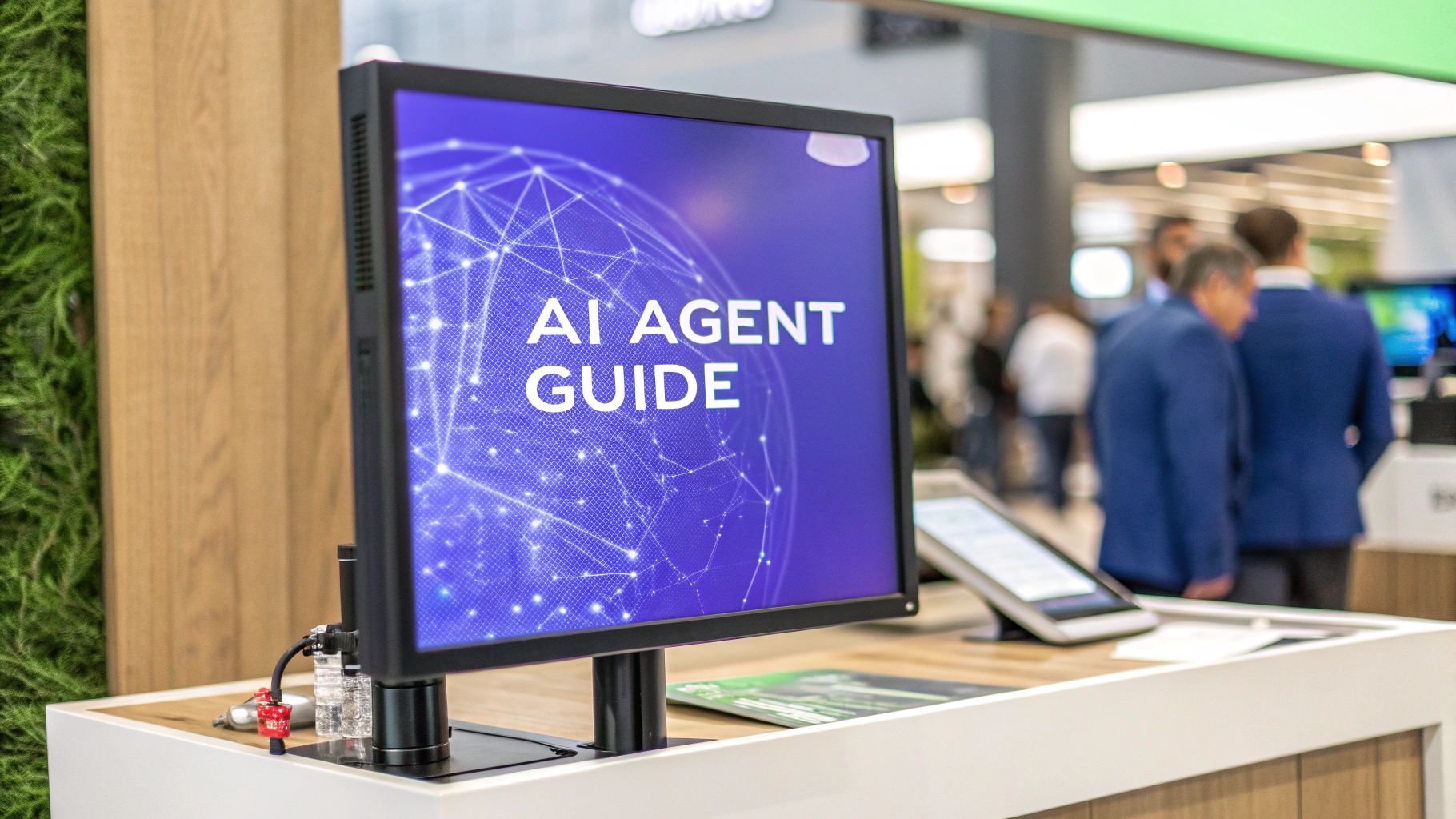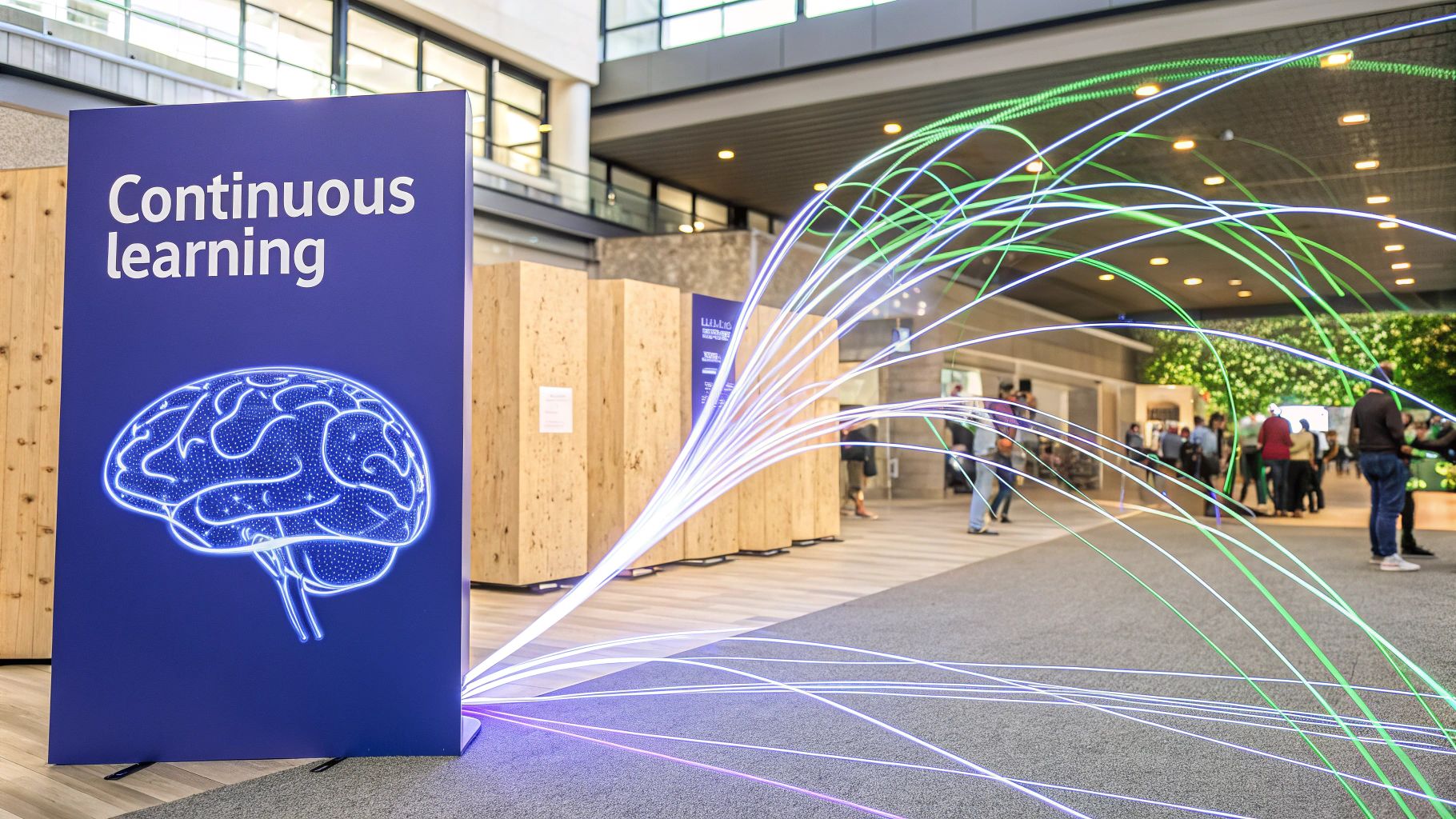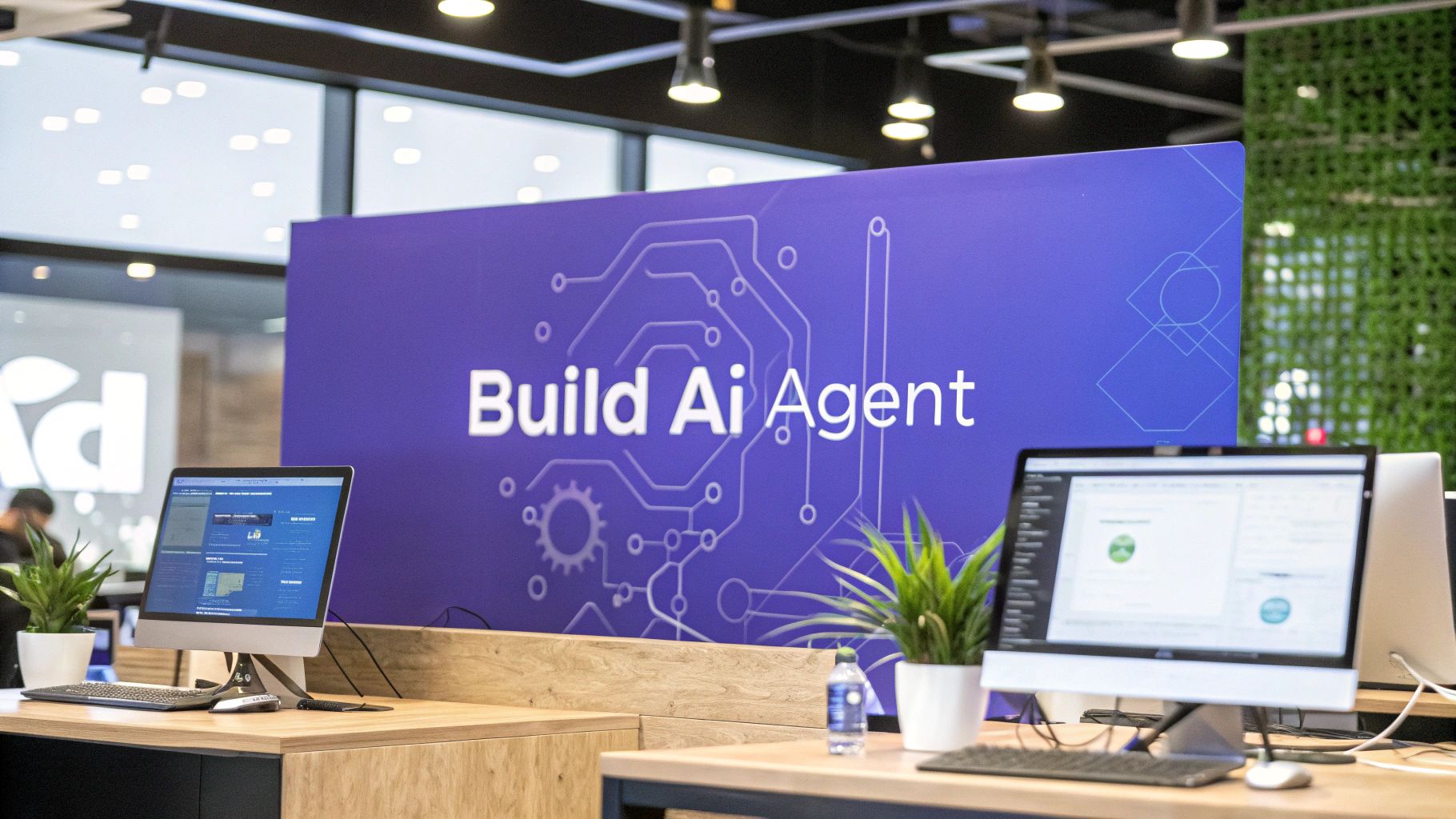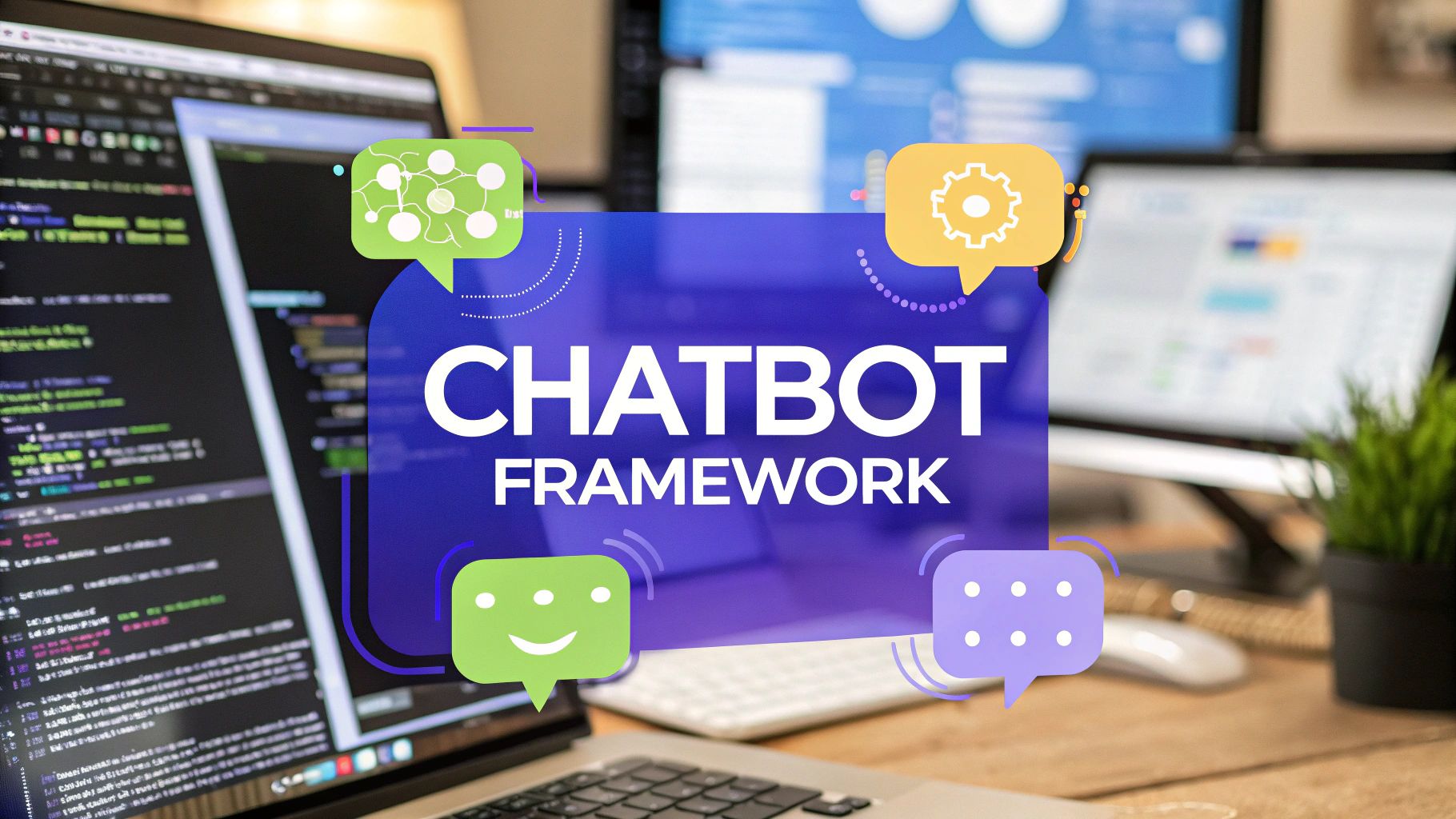What Is an AI Agent and How Does It Work?
Curious about what is an AI agent? This guide explains how they operate, their key components, and their real-world impact on business automation and growth.

An AI agent is an autonomous program designed to see its environment, make decisions, and take actions to hit specific goals. It does all of this without a human needing to manage every step.
Think of it less like a program you command and more like a proactive, digital teammate that can reason and act on its own.
The Modern Definition of an AI Agent
So, what does an AI agent look like in the real world? Let’s use an analogy. A calculator is a basic tool. You give it an input (2+2), it follows a fixed rule, and it gives you an output (4). It can't do anything else.
An AI agent is more like a skilled financial analyst. You can give it a high-level goal, like, "Find the best-performing tech stocks under $50 and pull together a report on their recent earnings."
From there, the agent gets to work on its own. It sees its digital world by tapping into stock market APIs, scanning news articles, and analyzing financial data. It makes decisions based on that information and then takes action, filtering stocks, compiling the data, and sending you the finished report.
This loop of seeing, deciding, and acting is what separates an agent from more basic forms of AI.
It’s easy to group AI agents with virtual assistants like Siri or Alexa, but they operate on different levels. Virtual assistants are mostly reactive. They wait for a specific command, then carry out a pre-defined task. An AI agent is proactive and goal-oriented.
This infographic breaks down the core functions of an AI agent pretty well.

You can see the continuous loop: the agent senses its surroundings, uses its internal logic to make choices, and then performs actions to get closer to its objective.
For a clearer picture, here’s a quick comparison of the key differences between autonomous AI agents and the command-based virtual assistants we’re all used to.
How AI Agents Compare to Virtual Assistants
The key difference is in their operational style. An agent is built for long-term, complex goals, while a virtual assistant is designed for immediate, simple commands.
An AI agent is defined by its autonomy. It actively works toward a goal, adjusting its strategy as new information becomes available. This is a fundamental shift from command-based AI to goal-driven AI.
This distinction is becoming more important as businesses start to see the value. AI agents are autonomous software entities that can perceive their environment, reason, and take action to achieve specific goals. It’s no surprise the global AI agent market hit around USD 5.4 billion in 2024 and is expected to jump to nearly USD 7.9 billion by 2025.
This massive growth shows how valuable this kind of autonomy is becoming. If you want to dig deeper, you can explore more data on the AI agent market growth to see the full trend.
The Core Components of an AI Agent
So, what exactly is an AI agent? The easiest way to think about it is to break it down into its core parts. Picture a digital person with a very specific job. For it to do that job, it needs a brain to think, senses to see its environment, and hands to take action.
Let's stick with a simple, practical example: an AI agent built to manage your travel bookings. You give it a straightforward command like, "Find me a round-trip flight to Denver for the first week of June, and keep it under $300."
This image shows the basic loop these components create to get the job done.

As you can see, the agent is in a constant cycle: it sees what's happening, decides what to do next, and then acts on that decision. This loop is what makes it autonomous.
The Brain: The Decision-Making Engine
First up is the "brain," the agent's reasoning or decision-making engine. This is where all the thinking happens. Most of the time, this part is powered by advanced AI language models, which give the agent the ability to understand what you want, plan the necessary steps, and make logical choices.
For our travel agent, its brain gets to work processing your request. It figures out it needs to check multiple airline websites, compare the prices it finds, and then filter everything based on your budget and dates. To get a better handle on how these models work their magic, you can learn more about AI language models in our detailed guide.
The Senses: Perceiving the Digital World
Next, an agent needs "senses" to gather information from its digital world. These are not physical eyes or ears, but sensors like APIs, web scrapers, or user inputs that feed it a constant stream of real-time data. A huge piece of this is interpreting human language, which relies on technologies like Natural Language Processing (NLP).
Our travel agent uses its senses to:
- Access airline APIs to pull current flight data.
- Read calendar data to check your availability.
- Monitor pricing websites for any last-minute fare changes.
Without these senses, the agent would be completely blind, unable to collect the information it needs to do its job. It would be like trying to book a flight without being connected to the internet.
The Hands: Taking Action
Finally, an agent needs "hands" to actually carry out tasks. In the AI world, these are called actuators, and they are what perform actions based on the brain's decisions.
Once our travel agent's brain has found the perfect flight, its actuators get to work. They might:
- Fill out the booking form on the airline's website automatically.
- Send you a confirmation email with your complete itinerary.
- Add the flight details directly to your digital calendar.
These three components, the brain, senses, and hands, work together in a continuous loop. The agent sees, thinks, and acts, moving one step closer to its goal with every cycle.
How AI Agents Learn and Improve

The real magic of an AI agent isn’t just that it can do things. It’s that it can learn from what it does and get smarter over time.
Think about the difference between an agent and a simple pre-programmed robot. That robot will follow the same fixed steps forever. An AI agent is designed to evolve. This ability to learn turns it from a basic tool into an intelligent partner.
The engine behind all this improvement is machine learning (ML). It’s a feedback loop. When an agent finishes a task, it looks at the outcome. Was it a success? Could it have been done faster or better? That analysis creates fresh data the agent uses to fine-tune its approach for next time.
For instance, a customer support agent might figure out that certain responses consistently lead to higher satisfaction scores. With ML, it learns to favor those effective replies in similar conversations, getting better with every interaction. It’s not just following a script, it’s actively learning from experience.
The Technologies Behind Agent Improvement
Beyond that core machine learning loop, a few other key technologies help agents make sense of their environment and make smarter moves. By 2024, agents powered by machine learning were already responsible for over 30% of the global market revenue, which shows how important this tech is for helping agents adapt. You can dig into the numbers in this AI agent market report.
Two of the most important technologies working behind the scenes are:
- Machine Learning (ML): This is the foundation of an agent's ability to learn. It involves training models on huge datasets to spot patterns, predict what will happen next, and adjust its decision-making as new information comes in.
- Natural Language Processing (NLP): This gives an agent the power to interpret and generate human language. It's what lets a sales agent see the nuance in a customer's email or a data analysis agent process text-based reports.
When you combine these technologies, an AI agent is in a constant state of learning. Every piece of new data, every user interaction, and every completed task becomes a lesson that makes it more effective for the next challenge.
This capacity for continuous improvement is what makes AI agents so powerful. They don’t just perform tasks; they start to master them. This dynamic learning process means an agent’s value keeps growing, making it an increasingly capable and reliable asset for any workflow.
Real-World Examples of AI Agents in Action
Knowing the components of an AI agent is one thing, but seeing them work is where it all clicks. These agents are already out in the wild, busy in different industries, handling complex jobs that used to eat up tons of human effort. They work behind the scenes, making businesses smarter and more responsive.
Let's move past the theory and look at a few concrete examples of what an AI agent can actually do for a business.
E-commerce Automation
Running an online store is a constant balancing act between inventory, pricing, and talking to customers. An AI agent can step in and manage these moving parts, acting as an autonomous operations manager.
Imagine an e-commerce shop that sells electronics. The business gives its AI agent a simple goal: maximize profit while keeping inventory tight. The agent gets to work, making decisions entirely on its own:
- It watches inventory levels: When stock for a popular product dips below a certain point, the agent automatically creates and sends a purchase order to the supplier. No human is needed.
- It adjusts pricing on the fly: The agent keeps an eye on competitor websites. If a rival drops their price on a similar camera, the agent instantly recalculates a competitive price for its own store, balancing profit margin with what the market is doing.
- It personalizes customer outreach: By looking at purchase history, the agent can see who bought what. If a customer bought a specific camera a few weeks ago, it can automatically send them a targeted email with an offer for a compatible lens.
The result is clear: optimized inventory, dynamic pricing that reacts in real-time, and personalized marketing that drives sales. It's a huge step up from someone manually checking stock or setting prices once a season.
Proactive IT Operations
In the IT world, small problems can snowball into disasters fast. A minor network hiccup can lead to major downtime, costing a company thousands. An AI agent can act as a vigilant network administrator that never sleeps, catching problems before they ever start.
Think about a big company with a sprawling internal network. An AI agent is tasked with keeping that network healthy and stable. Here’s what it does:
- Constant monitoring: The agent is always watching network traffic, server performance, and how well applications are running.
- Spotting anomalies: It quickly learns what “normal” network behavior looks like. When it sees an odd spike in data transfer or a server that's slow to respond, it flags it as something out of the ordinary.
- Automated fixes: Instead of just sending an alert and waking someone up, the agent takes action. If a server is overloaded, it might reroute traffic to a backup. If a security threat pops up, it can immediately isolate that part of the network to stop the threat from spreading.
By handling these issues on its own, the agent stops minor glitches from becoming full-blown outages. This means more uptime, better security, and an IT team that can focus on bigger projects instead of constantly putting out fires.
These examples show that an AI agent is more than an automation script. It’s a goal-driven system that perceives a dynamic environment and makes intelligent decisions to produce real business value.
From running online stores to securing corporate networks, the applications are growing every day. To explore a wider variety of these applications, our guide on AI agent use cases offers more examples across different sectors. For developers, a deeper look into the 12 Best AI Coding Assistant Tools for Developers provides another great perspective on how these agents are changing specific workflows.
Of course, here is the rewritten section with a more human, expert tone, following all the specified requirements.
The Tangible Business Benefits of AI Agents
So, we know what an AI agent is and how it works. That's great, but let's get to the real question every business asks: What's in it for me? Bringing this kind of technology into your operations goes way beyond just checking off an automation box. It leads to real, measurable improvements across the board, from day-to-day efficiency to your long-term strategy.
The first thing you’ll notice is a huge drop in manual, repetitive work. Just think about all the hours your team sinks into tasks like processing invoices, punching data into a CRM, or sorting through an endless queue of support tickets. An AI agent can take over those jobs, run them flawlessly, and free up your people to focus on the kind of work that actually requires a human brain, things like creativity, strategy, and critical thinking.
Boosted Efficiency and Productivity
One of the biggest wins with AI agents is that they work 24/7 without needing a coffee break or a good night's sleep. This non-stop operation means customers get faster answers and internal projects get turned around quicker. While your human team is on the clock for eight hours, an agent is working for twenty-four, literally tripling the potential output for certain tasks.
This constant availability has a direct impact on productivity. An agent can chew through thousands of data points or customer questions overnight, so your team walks in the morning to find a chunk of their work already done. This creates a much smoother workflow, letting people jump straight into higher-value activities.
The core value of an AI agent is its ability to tirelessly handle high-volume, rule-based tasks. This directly translates to significant cost savings and a more productive workforce, allowing your business to scale without having to scale your headcount at the same rate.
Smarter Decisions Through Data
Beyond just getting things done, AI agents are incredibly good at making sense of the data they're handling. They can spot patterns, trends, and outliers that a person might easily miss. For example, an agent managing your sales pipeline could flag that leads from a specific marketing campaign are converting at a 15% higher rate, giving you a clear signal to shift your ad spend.
This turns your everyday operational data into a goldmine of business intelligence. Instead of just looking in the rearview mirror at past performance, you can use these insights to make proactive, data-driven decisions that give you a real competitive edge.
To make this more concrete, let's look at how AI agents can drive improvements in different parts of a business.
Impact of AI Agents Across Business Functions
The table below breaks down some specific improvements you can expect when you put AI agents to work in key departments. It’s not just about doing things faster; it's about doing them smarter.
As you can see, the benefits are practical and specific. Bringing an AI agent into your business isn't just about tweaking efficiency. It’s about building a smarter, more responsive organization that's ready to scale.
Getting Started with Your First AI Agent
Ready to go from theory to practice? Building your first AI agent is a lot more approachable than you might think. The process isn't about jumping straight into code. It's about starting with a clear, strategic plan.
Think of it like drafting a job description for a new digital employee before you "hire" them. The journey begins by defining a very specific, measurable goal. What single, high-impact task do you want this agent to handle?
Instead of a vague goal like "improve sales," aim for something concrete, like "automatically qualify inbound leads from our website form and add them to the CRM." A well-defined objective is the bedrock of a successful agent.
Charting Your Course
Once you have a clear goal, the next step is choosing the right tools for the job. You don't always need a team of developers to get started. Many platforms now offer no-code or low-code solutions, letting you build powerful agents with a visual, drag-and-drop interface. For more specialized tasks, advanced frameworks give you the flexibility to create something completely custom.
The key steps in the process usually look something like this:
- Identify the Use Case: Find a repetitive, rule-based task that eats up a lot of time.
- Gather Your Data: Make sure the agent has access to the information it needs, whether that’s your customer database, product catalog, or internal documentation.
- Train the Model: Teach the agent how to do its job by giving it examples and defining its decision-making logic.
- Deploy and Monitor: Release the agent in a controlled way, maybe with a small team at first. Keep a close eye on its performance to spot any issues early.
A successful AI agent is rarely perfect on day one. The best approach is to start small, launch a minimal version, and then improve it based on real-world feedback. Continuous monitoring and refinement are what turn a good agent into a great one.
Planning for this iterative improvement is important. Set up feedback loops so you know when the agent gets it right and when it stumbles. This allows you to fine-tune its behavior over time, making it smarter and more effective with each cycle.
For a more detailed walkthrough, check out our complete guide to building an AI agent for step-by-step instructions.
A Few Common Questions About AI Agents
We've covered a lot of ground, but a few questions always pop up when people first start exploring AI agents. Let's clear up some of the common ones.
Aren't AI Agents Just Fancy Chatbots?
Not quite, and the difference comes down to one word: autonomy.
A chatbot is reactive. It waits for you to ask a question and then follows a script or pulls from a knowledge base to give you an answer. Think of it like a digital receptionist with a specific list of responses.
An AI agent is proactive. You give it a goal, like "find the best flight to London next week," and it independently figures out the steps to get there. It plans, acts, and adapts on its own, more like a project manager you can delegate tasks to.
How Secure Is It to Use an Agent with Sensitive Data?
That’s a fair question, and security is a big deal. Reputable AI agent platforms are built with strong encryption and access controls to keep your information safe.
When you're choosing a platform, look for one with clear security policies and transparent data handling practices. When set up correctly, a well-built agent can operate securely right alongside your existing systems, without putting anything at risk.
Do I Need to Be a Developer to Build One?
The technical skills required really depend on what you want to build. A few years ago, the answer would have been a definite "yes."
Today, modern no-code platforms have changed the game. You can build a genuinely useful AI agent using a drag-and-drop interface, with no programming knowledge needed. For super specialized or complex agents, a bit of coding knowledge is still helpful, but it’s no longer a barrier to getting started.
Can Multiple AI Agents Work Together?
Absolutely! This is one of the most exciting frontiers, often called multi-agent systems.
You can design a team of specialized agents that collaborate on a bigger, more complex goal. For instance, one agent could be in charge of gathering market data, another could analyze it for trends, and a third could take that analysis and draft a final report. They work together just like a human team, each bringing its own skills to the table.
Ready to build a smart, autonomous assistant for your business? With Chatiant, you can easily create custom AI agents trained on your own data. Start building your first AI agent today!


